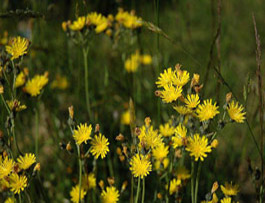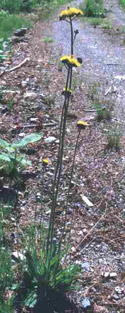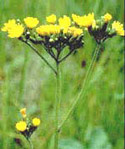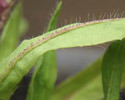Yellow Devil Hawkweed
Hieracium floribundum • Class B |
||
| Family Name: | Asteraceae family (ass-ter-AY-see-ee) | |
| Common: | Aster, daisy, or sunflower family | |
| Genus: |
Hieracium (hi-er-uh-KEE-um) Meaning: From the Greek meaning a hawk, referring to belief that hawks fed on the plant to strengthen eyesight |
|
| Species: |
floribundum (flor-ih-BUN-dum) Meaning: Free flowering or many flowers |
|
| Description: |
The plant has a basal rosette of narrow, pointed leaves, which are covered with a whitish or bluish waxy coating. The top of the leaf is smooth while the underside has scattered, bristly hairs, particularly along the mid-rib. The single flowering stem grows up to 32 inches tall, and is sparsely covered with bristly blackish hairs. In mid to late spring the stems are topped with 3 to 50 bright yellow flower heads in a flat-topped cluster, closely resembling a dandelion. |
| Why Is it a Noxious Plant? |
Hawkweeds are aggressive competitors of native plants and desirable vegetation. Its creeping growth fills in the gaps between other plants forming mats of rosettes and prevents other plants from establishing seedlings. |
| Where Does it Grow? |
It infests meadows, roadsides and fields and is especially invasive on poorer acidic soils. It prefers full to partial sunlight. |
| Facts: |
Yellow Devil hawkweed is one of only 6 known Pollen Allelopathic plants. The pollen released from its flowers discharges toxins that inhibit the seed germination, seedling emergence, and saprophytic growth of surrounding plants. |
| Control Options: |
Early detection and eradication are important to prevent the spread of hawkweed. As usual with invasive species, the best control measure for Yellow Devil Hawkweed is prevention. Above all, prevent plants from going to seed. .
|
| More Information: |
Visit Washington State Noxious Weed Control Board Here. Photo by Leo Michels
|
| More Pictures: |




